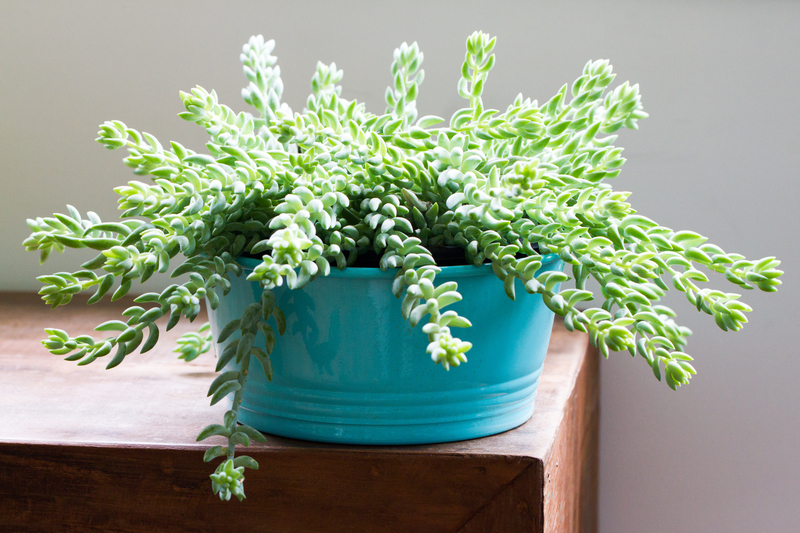Safeguarding Your Garden from Harsh Weather Conditions
Posted on 13/09/2025
Safeguarding Your Garden from Harsh Weather Conditions
Gardening enthusiasts invest significant love and labor into their green spaces, but unpredictable weather can threaten even the most well-tended plots. From torrential downpours and high winds to scorching heatwaves and biting frost, safeguarding your garden from harsh weather conditions is essential for ensuring its health and longevity. This comprehensive guide explores vital techniques and actionable advice for protecting your plants, soil, and overall garden ecosystem, empowering you to weatherproof your beloved outdoor sanctuary.
Understanding the Impact of Severe Weather on Gardens
Mother Nature's extremes can wreak havoc on garden health. Understanding these influences provides a foundation for creating effective defensive strategies.
Key Weather Threats to Gardens
- Heavy Rainfall: Can cause soil erosion, root rot, and nutrient leaching.
- Frost and Freezing Temperatures: Damage plant tissues, kill sensitive species, and stunt growth.
- High Winds: Uproot young trees, snap delicate stems, and shred leaves.
- Heatwaves and Drought: Lead to wilting, dehydration, sunscald, and increased pest infestations.
- Hailstorms: Bruise or destroy foliage and flowers, sometimes annihilating entire beds.

Assessing Your Garden's Vulnerability
Before implementing protective measures, *assess your garden's specific risks.* Consider your local climate patterns, microclimates within your yard, soil type, and plant selection.
- Does water pool in any area after rain?
- Is your garden prone to wind tunnels?
- What are the lowest spots susceptible to frost pockets?
- Which plants are most sensitive to extreme temperatures?
Essential Strategies for Protecting Your Garden from Harsh Weather
1. Wind Protection
Strong winds are notorious for damaging both mature and young gardens alike. Implementing windbreaks not only shields your plants but also improves microclimatic conditions.
- Plant Living Hedges: Rows of evergreens, shrubs, or even tall grasses provide natural barriers.
- Install Fences or Screens: Wooden, lattice, or mesh screens break the wind's force and shield vulnerable plants.
- Use Temporary Barriers: Burlap, plastic sheeting, or even old bedsheets can be erected ahead of storms.
Place windbreaks perpendicular to the prevailing winds for optimal protection. Strategic planning prevents wind-tunnels from forming, which can cause more harm than good.
2. Frost and Freeze Defense
Frost and cold snaps threaten sensitive plants, especially during unexpected late spring or early autumn chills. To keep your garden thriving:
- Cover Plants at Night: Use row covers, cloches, horticultural fleece, or upturned buckets to insulate tender buds and shoots.
- Add a Layer of Mulch: A thick layer of straw, bark, or compost helps regulate soil temperature and safeguards roots.
- Water Soil Before Freeze: Moist soil retains more heat, providing insulation; water thoroughly before cold weather hits.
- Bring Potted Plants Indoors: Move container plants to a garage, shed, or inside the house when extreme cold is forecasted.
Remove covers during the day to allow for sunlight and air circulation, preventing mildew and mold.
3. Shielding Against Heavy Rain and Flooding
Heavy rain poses risks to both garden structure and plant health. Soil erosion, nutrient runoff, and the drowning of sensitive roots are among the most common issues.
- Improve Drainage: Raise beds, install French drains, or incorporate organic matter like compost and sand to lighten heavy soils.
- Mulch Generously: Organic mulch absorbs water and prevents splash, reducing erosion and limiting soil compaction.
- Create Swales: Shallow trenches guide excess water away from plant roots and beds.
- Elevate Delicate Plants: Use mounds or add gravel beneath potted plants to keep them out of standing water.
Check drainage systems regularly to prevent blockages that may contribute to waterlogging.
4. Preparing for Heatwaves and Drought
No garden is immune to the effects of high temperatures and water shortages. Here's how to keep your plants hydrated and cool during challenging spells:
- Water Early or Late: Reduce evaporation by watering at dawn or dusk. Apply water directly at the root zone.
- Deep Watering: Less frequent, but deep watering encourages strong root growth and greater drought resistance.
- Utilize Mulch: Mulch acts as a barrier, keeping soil cool and moist for longer periods.
- Provide Shade: Erect temporary shade structures using shade cloth, old sheets, or specially designed garden canopies.
- Group Containers Together: Pots lose moisture faster; grouping them minimizes heat impact and retains humidity.
Install drip irrigation systems or soaker hoses for efficient water management during droughts.
5. Protecting Against Hail
Hail can devastate a garden in moments. While you can't control the weather, you can minimize damage:
- Hail Netting: Install fine mesh or hail netting over susceptible beds and delicate crops during storm season.
- Move Containers Under Cover: Place pots, hanging baskets, and seedlings beneath awnings or inside a greenhouse.
- Temporary Shelters: Portable pop-up canopies can save precious plants during an oncoming hailstorm.
Choosing Weather-Resilient Plants
The foundation of a weatherproof garden often starts with your choice of plants. Native species and those bred for your region generally fare better through extremes. Seek out plants with
- Deep root systems (which stabilize soil and resist drought)
- Thick or waxy leaves (better at withstanding wind and heat)
- Flexible stems (less likely to snap in wind or hail)
Consult with a local nursery for plant recommendations tailored to your area's unique climate and common weather threats.
Best Practices for Seasonal Garden Protection
Spring and Summer
- Monitor Weather Forecasts: Sign up for weather alerts and always stay one step ahead of the forecast.
- Prepare Protective Materials: Have row covers, shade cloths, and mulching materials on hand.
- Stake Tall Plants: Use garden stakes or cages to support rapidly growing or heavy-blooming plants prone to flopping.
- Inspect for Pests: High temperatures can invite insects and fungal diseases, so maintain regular garden checks.
Autumn and Winter
- Clear Debris: Remove dead material to prevent fungal diseases and reduce overwintering sites for harmful pests.
- Mulch Heavily: Fresh mulch insulates soil, protects roots, and buffers temperature changes.
- Winterize Tools and Infrastructure: Check greenhouses, cold frames, and garden fences for damage; repair as needed before storms arrive.
- Consider Row Tunnels: Extend your growing season and shield cold-sensitive crops with low tunnels or cold frames.
Maintaining Soil Health Under Stressful Conditions
A healthy soil ecosystem is fundamental for plant resistance and recovery from adverse weather events. Focus on building rich, resilient soil:
- Add Organic Matter: Mix in compost, leaf mold, or manure to enhance soil structure and water retention.
- Protect Soil Surface: Keep soil covered with living plants or mulch year-round to prevent erosion and desiccation.
- Avoid Compaction: Refrain from walking on wet or saturated soil, which destroys vital pore spaces needed for root growth.
Leveraging Modern Technology for Garden Protection
Today's gardeners have access to numerous *innovative tools* and resources for safeguarding outdoor spaces from harsh weather:
- Automated Weather Sensors: Monitor rainfall, temperature, and wind in real time to guide your protective action.
- Smart Irrigation Systems: Adjust watering schedules automatically based on local conditions, reducing waste.
- Garden Cameras: Observe and record garden behavior during adverse events to improve future responses.
- Mobile Weather Apps: Receive instant alerts about incoming storms, frosts, or heatwaves on your phone.
Combining traditional wisdom with modern technology creates a robust and responsive garden defense plan.

Long-Term Strategies for Weatherproof Gardening
- Diversify Your Plantings: Plant a variety of species, forms, and heights to promote resilience and reduce the risk of total loss.
- Design with Redundancy: Duplicate key plants or crops in multiple locations to mitigate damage from localized weather events.
- Invest in Structural Supports: Permanent fixtures, such as pergolas or arbors, can double as protection and beautiful features.
- Use Permeable Paths and Surfaces: Encourage groundwater recharge and discourage flooding by using gravel, wood chips, or permeable pavers.
Conclusion: Protecting Your Garden Year-Round
Safeguarding your garden from harsh weather conditions is an ongoing process, blending careful observation, smart design, and diligent preparation. By understanding local climate challenges and adopting resilient practices, you can create an attractive, functional, and enduring garden for all seasons. With proactive measures, your greenery can flourish no matter what nature throws its way--rewarding you with beauty, food, and enjoyment year after year.
Are you ready to weatherproof your garden? Start today and reap the benefits of a resilient and thriving outdoor oasis!

